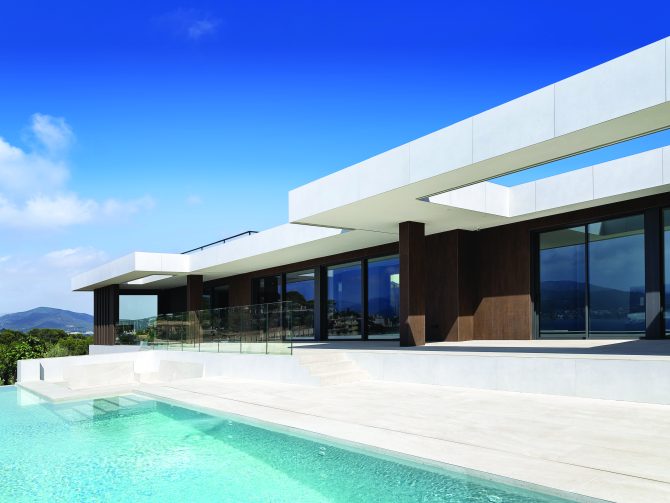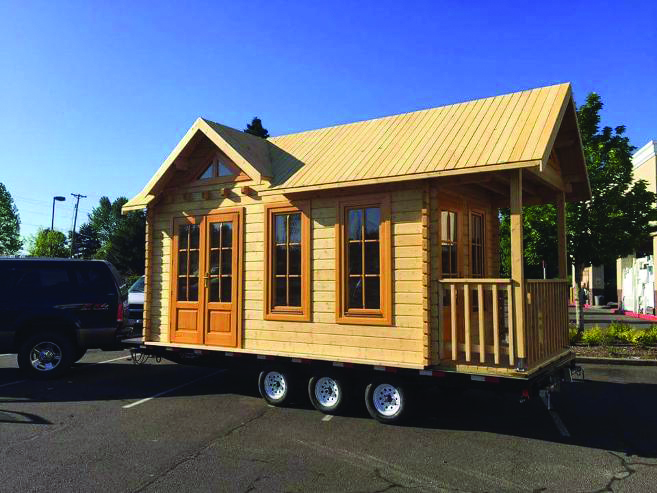The Pros and Cons of a Kit-Build Home in France

Ranging from basic to lavish, kit-build homes offer an option to create your own tailormade home in France for a very reasonable price, as Robin Gauldie discovers.
For many of us, the dream home in France is a cute village house with lavender-coloured shutters and a tiny garden, a mellow old stone farmhouse or, for the more ambitious, a roomy maison de maître in Normandy or Dordogne.
However, timber-framed houses have been part of France’s architectural heritage since medieval times, and present-day versions are part of a long tradition.
Starting from scratch by buying a patch of land in the area of your choice and building your own home may seem like an intimidating task. But buying a kit-build home (une maison kit in Franglais or, more correctly, une maison à monter soi-même) can be a quick, easy and affordable off-the-shelf solution.
A browse through property websites will turn up terrains à batir from as little as €10-€20 per square metre, depending on location. As with buying a house, asking prices vary regionally, and you will pay more for real estate close to Mediterranean or Atlantic beaches, airports and villages with services such as shops and restaurants.
Other key considerations include infrastructure – if you choose a piece of building land some distance from the nearest village, connecting to municipal water supply, sewerage, mains electricity and gas may be an issue, and you will need to budget for such connections, so get estimates from energy and water suppliers before you close the deal. Buying a piece of land that already has power and water laid on will cost more initially, but may be cheaper, and certainly easier, in the long run.

Tiro
The simplest solution may be to look for a plot in a lotissement zoned by the local commune for new-build homes, with services including electricity, water and sewerage ready- installed, but your house will have to comply with local planning conditions, so consulting the local mairie should be your very first step.
The plan local d’urbanisation (PLU) and plan d’occupation des sols will confirm that any prospective purchase is classified as a terrain à batir and define how big a house you’re allowed to build on it.
The PLU lays down a range of design requirements for all new-build properties, from maximum height to design of facades. If your chosen plot is anywhere near a building classified as historic, those requirements can be quite nit picking-down to materials to be used, dimensions of shutters and colour of paintwork, so finding a plot well away from classified historic zones is your best bet.
If your heart is set on a piece of land that turns out to be classified as non-constructible you may be able to apply for buildable status, especially if there are the remains or foundations of previous buildings on the site.
You can find out more about the legal ins and outs at plu-en-ligne.com
How much does a kit-build house cost?
Red tape out of the way, what can you get, how much does it cost and how long does it take? As a very rough rule of thumb, expect to pay around €1,000 per square metre of floor space. Add around €250 per square metre to have your house erected by professionals, a service offered by most kit-build suppliers. As with any new home, you will need to budget for approved professionals to carry out plumbing and electrical work.
How long will it take? From pouring concrete foundations (which need at least a fortnight to cure) to finished work, you’re looking at 10-12 weeks, weather permitting, before you can move in.
Some kit-build suppliers offer a virtually turnkey service, from delivering the components of your new home through to assembly, insulation, wiring and plumbing, and some will also fit kitchens and bathrooms. Most suppliers can also recommend construction companies, and you can also find specialist wooden home builders through the Union des Industriels et Constructeurs Bois (UICB).
If you’re confident in your DIY skills, putting the whole thing together yourself is an option. But even if you are handy with tools – and have plenty of willing helpers-at some point you will need the services of qualified local tradesmen like plumbers and electricians. DIY wiring is a big no-no in France. So you do need to figure those costs into your budget.
Looking on the bright side, wiring and plumbing a new kit-build home from scratch will almost certainly cost less, and be less hassle, than rewiring and replumbing an old stone-built fixer-upper.
One of the cheapest and simplest kit-build offerings comes from Baticos, a specialist timber-building company based in Guewenheim, near Mulhouse. It is promoting flat- pack A-frame homes that come partly pre-assembled and are founded on long stakes instead of a concrete slab, speeding up construction so that Baticos claims its houses can be completed in just two weeks.

Lodge Homes Spain
Compact one-bedroom houses with around 40 square metres of floor space over two levels start at around €40,000.
Lodge Homes Spain offers bespoke DIY wooden homes delivered from its base in Spain to sites throughout France, with lodge-style homes starting from around €52,000. Company owner Al Hewitt points out some of the advantages of kit-build home over conventional buildings.
“Due to the terrain in part of France, a home supplied a a kit means a much quicker lead time and cheaper haulage,” he says.
“Building on site from tim requires a good level of DIY skills rather than a qualified builder. The timber we use is certificated and is from cold country, giving a dense grain for better insulation. It is mostly supplied as a twin wall, which provides for a co environment and cheaper running costs.”
Like Alan, Lars Mellblom, director of Tiro, is a fan of Scandinavian timber and ext the virtues of a kit-build hon Based in Normandy, Tiro has sold and delivered more than 80 kit homes since 2004.
“The kit we supply is only the shell of the house,” Lar explains. “The interior is empty, and the foundations. are not included. The price for the kit, VAT included, represents about one-third of the total building cost if entirely self-built.
“Such a house is easy to build, economical and quick to complete,” Lars says. “The wood comes from Swedish Lapland. It is very tight grown, graded according to its mechanical resistance and shaped with Scandinavian precision. The kit is delivered from Sweden by boat and road to the building site, and transport and on-site technical assistance for self-builders are included in the price.”
Tiro’s basic kit comprises the wood, wood-based board, vapour barrier and assembly supplies for one house. Internal walls and fittings are optional, so buyers can decide how and where they want to position rooms, doors and windows.
Lars says DIY kit builders need to be able to lift weights of up to 60kg (not necessarily alone) and have a good head for heights. As a rule of thumb, he advises, the total cost of completion can be around three times the price of the basic kit. He also cautions that French banks will not provide loans to self-builders, as the 10-year building guarantee normally required for new-builds is not available for DIY properties.
That also means that if you want to sell on your DIY home within 10 years of completing it, you must provide the buyer with some form of indemnity against construction faults.
If you’re looking for something altogether sleeker, shinier and less rustic-more appropriate perhaps to a Mediterranean location than Dordogne or Normandy – Spanish-based company in HAUS offers high- end, prefabricated houses, built at their studio-factory in Valencia, then transported to your chosen location in France. In other words: plug and play, not nuts and bolts.
There’s no Norwegian wood involved here: founder manager architects and brothers, Rubén and Sergio Navarro, have developed a modular building concept that makes extensive use of concrete, steel and glass, with designs pre-adapted to meet local building regulations. The company boasts of a turnkey, fixed-price offer, guaranteeing price and delivery time, with completion ready for delivery in five months. If you want to go full oligarch, you can order designer-brand interior and furniture and a custom-built prefab pool surrounded by a landscaped garden.
The catalogue offers smaller homes as well as opulent mansions, based around what the Navarros describe as the ‘four axes’ of ‘Mediterranean warmth, high-tech Oriental minimalism, Italian elegance and Nordic purity’. These, though, are not homes for those on a tight budget: even for the smallest you’re looking at big six-figure prices.
A kit-build home may not be to everyone’s taste, but the advantages are plentiful not least because a newly constructed kit home will not turn into a bottomless money- pit that needs endless repairs and upgrading, like so many older French homes. Building from scratch allows you to tailor make your home to your own requirements.
Do your homework carefully, don’t cut corners, and it needn’t be a terrifying task.
Thinking of moving to France?
The unique mix of legal, financial and tax advice along with in-depth location guides, inspiring real life stories, the best properties on the market, entertaining regular pages and the latest property news and market reports makes French Property News magazine a must-buy publication for anyone serious about buying and owning a property in France.
Lead photo credit : InHaus
Share to: Facebook Twitter LinkedIn Email
Leave a reply
Your email address will not be published. Required fields are marked *




